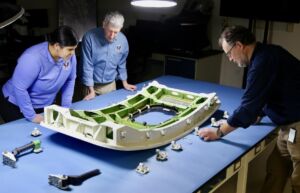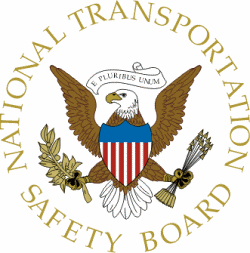This is all I have to close to out the week...
Have a safe weekend!
Tom
Bedford Confirmed as New FAA Administrator
Senators vote 53-43 in favor of the former Republic Airways CEO.
By Zach Vasile
Former Republic Airways CEO Bryan Bedford has been confirmed as the new administrator of the FAA.
The U.S. Senate confirmed Bedford in a 53-43 vote Wednesday afternoon.
Bedford replaces Chris Rocheleau, who has served as acting FAA administrator since January following the resignation of Joe Biden appointee Michael Whitaker.
Up until recently, Bedford served as president and CEO of Indiana-based Republic, positions he held since joining the airline in 1999. He retired July 2 and was replaced by chairman David Grizzle.
President Donald Trump tapped Bedford to serve as the next FAA administrator in March, citing his depth of industry experience.
Commitment to Safety
While Bedford’s nomination won support from the major U.S. airlines, the Aircraft Owners and Pilots Association (AOPA), and various industry groups, his positions on safety regulations, including the FAA’s 1,500-hour rule, generated pushback from the Air Line Pilots Association (ALPA) and congressional Democrats.
The rule requires a minimum of 1,500 hours of flight time for first officers seeking the airline transport pilot (ATP) certificate. During a confirmation hearing in June, Bedford did not directly respond to a question asking if he would stand by the regulation, though he said he would not compromise safety at the FAA.
ALPA contends that aviation fatalities are down more than 99 percent since the rule took effect in 2012.
Bedford also voiced misgivings about the airline industry’s mandatory retirement age for pilots, currently at 65.
“Those [who] wish to serve having an arbitrary mandatory retirement age doesn’t seem like the right answer to me,” he said during the hearing.
Bedford also faced criticism over a biography on Republic’s website that claimed he had a commercial pilot license (CPL). Bedford is a certificated private pilot but never obtained a commercial credential.
After the issue was brought to light by Politico, the U.S. Department of Transportation issued a statement defending Bedford, and his biography on Republic’s website was altered.
FAA in Flux
Bedford takes the helm of the FAA at a pivotal time for the agency. It is working to reverse a shortage of roughly 3,500 air traffic controllers while also overhauling the nation’s ATC equipment and physical infrastructure.
A multibillion-dollar plan put forward by the Transportation Department in May envisions building six new FAA ATC centers and 15 towers by 2028, which would be the largest and most rapid ATC buildout since the 1960s.
Bedford has said he will review the department’s plan and “identify where additional leadership or coordination” can be provided.
The FAA is also overseeing safety and quality processes at Boeing following quality control problems with the 787 Dreamliner and the blowout of a door plug on an Alaska Airlines 737 Max 9 in 2024.
https://www.flyingmag.com/bedford-confirmed-as-new-faa-administrator/?oly_enc_id=3681J3205156A2X
NTSB releases final report on Alaska Airlines flight 1282
On July 10, 2025, the National Transportation Safety Board (NTSB) issued its final report on the Alaska Airlines flight 1282 in-flight mid exit door plug separation. The Board met on June 24, 2025, to adopt the final report.
Safety Board (NTSB) issued its final report on the Alaska Airlines flight 1282 in-flight mid exit door plug separation. The Board met on June 24, 2025, to adopt the final report.
The accident involved a Boeing 737-9, which experienced an in-flight separation of the left mid exit door plug and rapid depressurization when climbing through about 14,830 ft after takeoff from Portland International Airport, Portland, Oregon.
The investigation determined that the probable cause of this accident was the in-flight separation of the left MED plug due to Boeing’s failure to provide adequate training, guidance, and oversight necessary to ensure that manufacturing personnel could consistently and correctly comply with its parts removal process.
As a result of this investigation, the NTSB issued new safety recommendations to the FAA and Boeing. Previously issued recommendations were reiterated to the FAA, Airlines for America, the National Air Carrier Association and Regional Airline Association.
Visit the investigation page.
NTSB Prelim: Aeronca 7AC
Airplane Climbed To 100 Ft Above Ground Level, At Which Time The Airplane Experienced A Total Loss Of Engine Power
Location: Westphalia, MI Accident Number: CEN25LA186
Date & Time: May 24, 2025, 13:00 Local Registration: N2659E
Aircraft: Aeronca 7AC Injuries: 1 None
Flight Conducted Under: Part 91: General aviation - Personal
On May 24, 2025, at 1300 eastern daylight time, an Aeronca 7AC, N2659E, was substantially damaged when it was involved in an accident near Westphalia, Michigan. The commercial pilot was not injured. The airplane was operated under Title 14 Code of Federal Regulations as a Part 91 personal flight.
The pilot stated that he flew to Forest Hill Airport, Westphalia, Michigan, where he performed a full stop landing and taxied back on the runway for takeoff. The subsequent takeoff was normal until the airplane climbed to 100 ft above ground level, at which time the airplane experienced a total loss of engine power. The pilot then performed a forced landing to a field where the airplane touched down and nosed over due to muddy field conditions. The airplane sustained substantial damage to both wings.
The airplane was retained from further examination.
FMI: www.ntsb.gov
NTSB Final Report: Schweizer SGS 2-33A
Glider Encountered A Loss Of Lift And There Was Not Sufficient Altitude To Reach The Airport
Location: Hood River, Oregon Accident Number: WPR25LA138
Date & Time: April 19, 2025, 11:37 Local Registration: N5786S
Aircraft: Schweizer SGS 2-33A Aircraft Damage: Substantial
Defining Event: Loss of lift Injuries: 2 None
Flight Conducted Under: Part 91: General aviation - Instructional
Analysis: The flight instructor reported that while turning final, the glider encountered a loss of lift and there was not sufficient altitude to reach the airport. The instructor chose to land in an orchard, and during the landing roll, the glider struck several small trees, which resulted in substantial damage to the left wing and left horizontal stabilizer.
The pilot reported that there were no preaccident mechanical malfunctions or failures with the glider that would have precluded normal operation.
Probable Cause and Findings: The National Transportation Safety Board determines the probable cause(s) of this accident to be -- The glider’s encounter with atmospheric conditions where the lift was not sufficient to maintain flight.
FMI: www.ntsb.gov

Today in History
34 Years ago today: On 11 July 1991 A McDonnell Douglas DC-8-61 passenger plane, registered C-GMXQ was destroyed in an accident near Jeddah-King Abdulaziz International Airport (JED), Saudi Arabia. All 261 on board were killed.
| Date: | Thursday 11 July 1991 |
| Time: | 08:38 |
| Type: | McDonnell Douglas DC-8-61 |
| Owner/operator: | Nigeria Airways, lsf Nationair |
| Registration: | C-GMXQ |
| MSN: | 45982/345 |
| Year of manufacture: | 1968 |
| Total airframe hrs: | 49318 hours |
| Cycles: | 30173 flights |
| Engine model: | Pratt & Whitney JT3D-3B (Q) |
| Fatalities: | Fatalities: 261 / Occupants: 261 |
| Other fatalities: | 0 |
| Aircraft damage: | Destroyed, written off |
| Category: | Accident |
| Location: | 2,8 km S of Jeddah-King Abdulaziz International Airport (JED) - Saudi Arabia |
| Phase: | Approach |
| Nature: | Passenger - Non-Scheduled/charter/Air Taxi |
| Departure airport: | Jeddah-King Abdulaziz International Airport (JED/OEJN) |
| Destination airport: | Sokoto Airport (SKO/DNSO) |
| Confidence Rating: | Accident investigation report completed and information captured |
Narrative:
A McDonnell Douglas DC-8-61 passenger plane, registered C-GMXQ was destroyed in an accident near Jeddah-King Abdulaziz International Airport (JED), Saudi Arabia. All 261 on board were killed.
The DC-8 jetliner was owned by Canadian airline Nationair which operated the plane on behalf of Nigeria Airways to fly hajj pilgrims between Nigeria and Saudi Arabia. Nigeria Airways flight 2120 took off from Jeddah's runway 34L at 08:28, bound for Sokoto (SKO), Nigeria.
During the takeoff run, about 15 seconds after brake release, an oscillating sound was heard in the cockpit. Within two seconds, the flight engineer said: "What's that?" The first officer replied: "We gotta flat tire, you figure?" Two seconds later, an oscillating sound was again heard. The captain asked the first officer: "You're not leaning on the brakes, eh?" The first officer responded: "No, I 'm not, I got my feet on the bottom of the rudder." By this time, the aircraft had accelerated to about 80 knots. Marks on the runway showed that the No.1 wheel on the left hand main landing gear started to break up at about this time. In addition, the left and right flanges of No.2 wheel began to trace on the runway; rubber deposit from No.2 tire continued which appeared to be from a deflated tire between the flanges.
At 28 seconds after brake release, a speed of 90 knots was called by the captain and acknowledged by the first officer. The captain called V1 about 45 seconds after brake release. Two seconds later, the first officer noted "sort of a shimmy like if you're riding on one of those ah thingamajigs."
The captain called "rotate" 51 seconds after brake release and the airplane lifted off the runway.
Witnesses noticed flames in the area of the left main landing gear. The flames disappeared when the undercarriage was retracted.
During the next three minutes several indications of system anomalies occurred, which included a pressurization system failure, a gear unsafe light and a loss of hydraulics.
The captain requested a level-off at 2000 feet because of the pressurization problem. In his radio call the captain used the callsign "Nationair 2120" instead of "Nigerian 2120" and the controller mistook the transmission to be from a Saudi flight returning to Jeddah and cleared The Jeddah bound aircraft to 3000 feet. The captain of the accident aircraft, however, acknowledged the ATC transmission without a call sign, saying "understand you want us up to 3000 feet."
This misunderstanding continued for the next three minutes with ATC assuming that all calls were from the Saudi flight, not from the accident aircraft.
About four minutes after brake release the captain called ATC and reported that the aircraft was leveling at 3000 feet. The first officer then interrupted with " ... declaring an emergency. We 're declaring an emergency at this time. We believe we have ah, blown tires."
As the aircraft continued on the downwind heading, a flight attendant came into the cockpit and reported "smoke in the back ... real bad." A few moments later, the first officer said "I've got no ailerons."
The captain responded: "OK, hang on, I've got it." It was the last record on the CVR, which failed (along with the flight data recorder [FDR]) at 08:33:33.
The ATC controller gave a heading to intercept the final approach and thereafter continued to give heading information.
Meanwhile, during the downwind and base legs, the fire had consumed the cabin floor above the wheel wells , permitting cabin furnishing to sag into the wheel wells. When the gear was probably extended at 11 miles on the final approach, the first body fell out because fire had burned through the seat harness. Subsequently, with the gear down and a forceful air supply through the open gear doors, rapid destruction of more floor structure permitted the loss of more bodies and seat assemblies. Despite the considerable destruction to the airframe, the aircraft appeared to be controllable.
Eight minutes after brake release and 10 miles from the runway, the captain declared an emergency for the third time, saying, "Nigeria 2120 declaring an emergency, we are on fire, we are on fire, we are returning to base immediately."
The aircraft came in nose down and crashed 9,433 feet (2,875 meters) short of the runway at 08:38.
FINDINGS RELATED TO CAUSE:
1. The organisational structure for the deployment team was ill-defined and fragmented.
2. Deployment maintenance personnel were not qualified or authorised to perform the function of releasing the aircraft as being fit to fly.
3. The release of the aircraft as being fit to fly was delegated to non-practising Aircraft Maintenance Engineers whose primary function was to operate the aircraft as flight crew members.
4. The aircraft was signed-off as fit for flight, in an unairworthy condition, by the operating flight engineer who had no involvement in the aircraft servicing.
5. The #2 and #4 tyre pressures were below the minimum for flight dispatch. Other tyres may also have been below minimum pressures.
6. Maintenance personnel were aware of the low tyre pressures but failed to rectify the faults.
7. The mechanic altered the only record of the actual low pressures, measured by the avionics specialist on 7 July, four days before the accident.
8. There was no evidence that the tyre pressures had been checked, using a tyre pressure gauge, after 7 July.
9. The lead mechanic was aware of the low tyre pressures.
10. The persons who were aware of the low pressures had insufficient knowledge of the hazards of operating at low tyre pressures.
11. The project manager was aware of a low tyre pressure but was not qualified to assess its importance.
12. The project manager was responsible for the aircraft schedule and directed that the aircraft depart without servicing the tyre.
13. The lead mechanic who was aware of the requirement for, and had requested nitrogen for tyre servicing, did not countermand the decision of the project manager.
14. There was no evidence to indicate that this flight crew were ever informed of the low tyre pressures.
15. The aircraft departed the ramp in an unairworthy condition.
16. During the taxi from the ramp to the runway, the transfer of the load from the under-inflated #2 tyre to #1 tyre on the same axle, resulted in overdeflection, over-heating and structural weakening of the #1 tyre.
17. The #1 tyre failed very early on the take-off roll due to degeneration of the structure, caused by over-deflection.
18. The #2 tyre failed almost immediately after #1 due to over-deflection and rapid over-heating when the load was transferred from the #1 tyre.
19. The #2 wheel stopped rotating for reasons not established. Friction between the wheel/brake assembly and the runway generated sufficient heat to raise the temperature of tyre remnants above that required for a tyre fire to be self-sustaining. Rubber remnants ignited during the take-off roll.
20. Numbers 1 and 2 wheels were severely damaged and at least one piece of #1 wheel rim struck the airframe, becoming embedded in the left flap.
21. The crew were aware of unusual symptoms early and throughout the takeoff roll; the captain continued the take-off.
22. The aircraft was not equipped with warning systems which would have provided the flight crew with adequate information on which to make a decision to reject the take-off after tyre(s) failure.
23. The captain did not receive sufficient cues to convince him that a rejected take-off was warranted.
24. The crew retracted the gear, consistent with company procedures, and burning rubber was brought into close proximity with hydraulic and electrical system components.
25. The evidence indicates that the wheel well fire involved tyres, hydraulic fluid, magnesium alloy and fuel. The fuel was probably introduced as a result of "burn through" of the centre fuel tank.
26. Fire within the wheel wells spread and intensified until the cabin floor was breached and control systems were disabled.
27. The fuel increased the intensity of the fire until, shortly before impact, airframe structural integrity was lost.
28. Tyre characteristics and performance are not adequately addressed during training and licensing of both flight crews and technical personnel.
29. The aircraft operator's tyre inflation pressures did not accurately reflect what was contained in the aircraft
